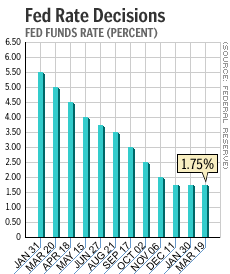
NEW YORK (CNN/Money) - The Federal Reserve left a key interest rate unchanged Tuesday and said the risks to the U.S. economy were evenly balanced between a risk of economic weakness and a risk of inflation, the first time in three years it had expressed such a neutral view of the economy.
Fed policy makers decided to leave their target for the federal funds rate, an overnight bank lending rate, unchanged at 1.75 percent, the lowest level in 40 years. The discount rate was also left unchanged at 1.25 percent. The fed funds rate forms the basis for banks' prime lending rates and affects the cost of borrowing for consumers and businesses.
The Fed also changed its "bias" from a position of guarding against further economic weakness towards a stance that saw the risks to the economy as being balanced between the Fed's twin goals of fueling growth and tempering inflation -- setting the stage for future interest-rate increases, if economic growth warrants it.
"The information that has become available since the last meeting of the [Federal Open Market] Committee indicates that the economy, bolstered by a marked swing in inventory investment, is expanding at a significant pace. Nonetheless, the degree of the strengthening in final demand over coming quarters, an essential element in sustained economic expansion, is still uncertain," the Fed said in the statement accompanying its decision.
The Fed said all 10 of its voting members supported the decision.

The move was widely expected by the markets, and U.S. stock prices gave up earlier gains after the announcement and closed slightly higher. Treasury bond prices rose.
"As expected, the Fed proves once again that it doesn't like to surprise financial markets," said Anthony Chan, chief economist at Bank One Investment Advisors. "Everyone including my elementary school children were expecting the Fed to move towards neutrality."
To fight the effects of a recession that likely began in March 2001, the Fed cut its target for short-term interest rates 11 times in 2001, a record for a calendar year. But it decided in January to leave rates alone, and Chairman Alan Greenspan has said in recent weeks that the recession seemed to be over, though the recovery could be muted.
As a result, most economists expected the Fed's balanced statement. The last time it made a similar assessment was in March 1999, and it had expressed a bias towards rate-cutting since December 2000.
The Fed manipulates monetary policy to simultaneously keep economic growth strong and inflation under control. In recent weeks, data showing resilient consumer sentiment, the first increase in business inventories in a year, a stabilizing labor market and the end of a 19-month recession in the manufacturing sector have convinced Greenspan and other observers that the economy is on the mend.
While the Fed expects economic growth of between 2.5 percent and 3 percent this year, a number of economists suspect growth could be much stronger than that. Among the most optimistic economists are Robert DiClemente at Salomon Smith Barney, who recently raised his outlook for first-quarter gross domestic product (GDP) growth to 5.2 percent from 4.6 percent, and Bruce Steinberg of Merrill Lynch, who raised his outlook for the quarter's economic growth to between 5 percent and 6 percent from an earlier estimate of 3.5 percent.
"All the news is telling us we're looking at an economy poised to do better, that excessive caution by the business community kept the economy from growing more than it did in the [fourth] quarter, and now businesses are starting to catch up to where the consumer is," J.P. Morgan Chase senior economist James Glassman told CNNfn's Money Gang program.
A stronger economy usually leads to a greater risk of inflation, forcing the Fed to raise rates. The implied yield on the federal funds futures contract, often an accurate gauge of the Fed's future rate target, shows traders think the Fed will raise rates a quarter-percentage-point at its next meeting in May and push rates as high as 3 percent by the end of the year.
| |
 Related links
Related links
| |
| | |
| | |
|
But inflation hasn't been a problem for a long time, and some economists think it will continue to be a distant threat, especially since the rest of the world is still suffering from economic weakness, allowing the Fed to leave rates lower for longer.
"We may actually find that inflation moves lower because there's a lot of excess capacity [in factories] here and around the world," Glassman said. "You get the best inflation performance in the first couple years of a recovery; with the very strong productivity gains, that gives the Fed time [to leave rates lower]."
But the Fed will eventually need to bring rates higher, economists say, even if just to put them at a "normal" level in comparison with strong economic growth.
"With the economy doing so well, there's no reason to be flooring the accelerator, and that's what they're doing [with the federal funds rate at 1.75 percent]," Glassman said.

|

